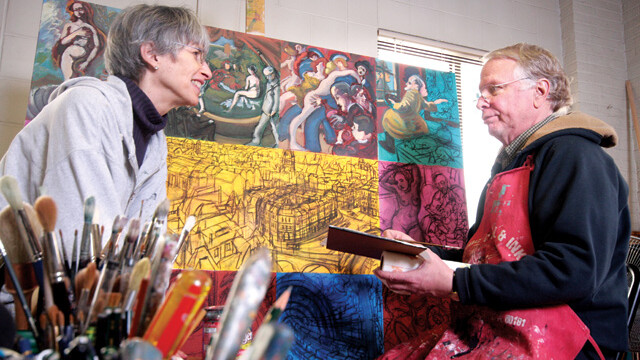SweetheARTS
V1 investigates the magic that happens when two artists get together
Kinzy Janssen, photos by Andrea Paulseth |

~
Bill Hamilton
Guitarist, drummer, and/or singer
(The Excellent Adventure, Little Willie, Eau Claire Blues All Stars, & the Old Fashioneds)
Tiffany Bailey
Ceramic artist; wants to teach at the college level
~
To enter a home shared by a musician and a visual artist is to enter a sanctuary of the senses. When I paid a visit to Tiffany Bailey and Bill Hamilton, my eyes couldn’t stop wandering the room, from the shuffle of colored brontosaurus drawings on the table (their son Kai’s latest work) to the series of photographs and sketches covering the walls to capacity. Meanwhile, I absorbed Bill’s warm, relaxed plucking and strumming.
 Bill and Tiffany’s relationship as married, working artists is largely as harmonious as their home suggests. The one overarching issue they confide in me about is their constant, careful management of time. Studio time for both of them is frequent and essential, and sometimes comes at the expense of a few hours with the family.
Bill and Tiffany’s relationship as married, working artists is largely as harmonious as their home suggests. The one overarching issue they confide in me about is their constant, careful management of time. Studio time for both of them is frequent and essential, and sometimes comes at the expense of a few hours with the family.
“If there wasn’t enough time for me to devote to art … that’s where relationship turmoil would come into play,” says Tiff, and she knows the same goes for Bill. So when Bill has a slew of back-to-back gigs, Tiffany will cover the house more. “But it always comes back,” she says, meaning that there are periods of time when she concentrates more on her pottery than running a household. “To be an artist is kind of a selfish thing,” she admits.
But while time – especially lack of it – can seem a curse, it’s also a point of connection. Since they’re both so busy and passionate, they understand each other’s flurry of activity and occasional absences. They speculate that non-artists who are married to artists may feel like they’re living for the other person, which can be draining.
Though their mediums couldn’t be more different, they understand artistic drive. So when self-motivation lags, their better half intervenes. Bill will persuade Tiffany to go down to the studio on the evenings she’s feeling tired. “And I appreciate it,” says Tiffany, “because those are two or three hours that I could have easily putzed away.”

~
Jon Loomis
Teaches creative writing courses at UWEC; novelist; poet
Allyson Loomis
Teaches creative writing courses at UWEC; writer of fiction and nonfiction
~
Looking back on their courtship, Jon and Allyson Loomis will tell you theirs was “sweet, Victorian, and epistolary,” meaning they exchanged months’ worth of letters before connecting meaningfully in person. As writers and English professors, it is fitting that they should describe their romance in language you might find on a list of “literary terms and definitions.”
Seven years and two kids later, Jon and Allyson are still writing. It is a taxing craft that occasionally requires them to be inseparable … from their laptops. Though Allyson says they “compete bitterly for time to write,” the two of them always look forward to the end of the day when they will convene, seeking commentary. They have fond memories of swimming in a pool when Allyson was pregnant with Henry, hashing out the hazy territory beyond page 200 of High Season.
“I’ve been trying to get her name in there as co-author to these mysteries, but she keeps saying no,” says Jon. “Her comments are spot-on. … She’ll tell me to add a monkey, and I will.”
Allyson laughs it off. “All I have to do is think of the scene – you have to write it. That’s the best way to be a writer!”
Jon, who holds an MFA in poetry, has written two crime novels and is working on a third. Allyson holds an MFA in creative writing and has published short fiction and non-fiction pieces in quite a few literary magazines, including Harper’s.
“It’s a weird drive, and there’s no escaping it, and whoever you’re married to better understand that,” says Jon, who lightheartedly compares the “habit” to a coke addiction, much to Allyson’s alarm.
“It just kind of makes sense that artists are married to each other,” says Allyson, pointing out that creative people naturally form networks. She likes having an instantly available reader who is part of the public realm. Jon appreciates Allyson’s attitude toward those publishers’ relentless rejection notes. “It’s always, ‘Those assholes! What do they know?’ ” he says. “So it’s very supportive.”
~
Rose Dolan-Neill
Volunteer Coordinator for the State Theater; actress
Josh Dolan-Neill
Student; actor, director; painter
~
As founding members of Barebones Ensemble, Rose and Josh Dolan-Neill had probably spoken to one another in passing. But it wasn’t until they were entrenched in theatrical roles, speaking lines to one another in an intense, two-character play, that they realized the potential in one another.
Married for nine years this year, Josh and Rose appreciate each other for many reasons, but as actors they appreciate the level of commentary they can expect from their spouse. Brainstorming sessions between them can be spontaneous, flowing over mundane housekeeping tasks like dishes.
Rose says she agrees with about 75 percent of Josh’s interpretive ideas for their Barebones plays. But of the ideas she finds boring or repetitive, Rose doesn’t mince words. “It’s brutal,” she says, then backtracks. “Is it brutal?” They look at each other and agree, “Yeah it’s brutal.”
“But it gets to the truth!” says Rose. “I think it’s because we’re married that we can be so honest. If you can’t be honest with your spouse, when can you be?” she asks.
They’ve discovered, however, that being in a close, committed relationship doesn’t make communicating an artistic vision any easier.
“You’d think when you know someone so well, it’d be easier, or you’d think it’d somehow get easier with more education,” she says. “But feelings and artistic ideas are still so hard to communicate.”
While Rose organizes and “wrangles in” 300 volunteers for the State Theater, Josh works nights at the Eau Claire Academy and is also a student at UW-Eau Claire. He paints, too – an art form that the couple has generally decided won’t bring them together much, and that’s OK. They have theater.
Of their shared identity as actors (and sometimes directors), Rose says, “I love it; it’s freeing. I don’t find it difficult at all.”
“Financially, maybe, it’s difficult, since we’re both poor artists, basically,” Josh says. “But finding a project we can both really get behind … together … makes up for it.”

~
Barbara Shafer
Lecturer of various art topics at UW-Eau Claire; painter; dancer
Anders Shafer
Professor Emeritus of Life Drawing; painter; poet
~
Barb and Andy Shafer paid to have their spacious studio divided by a tall white wall.
This is because, 99 percent of the time, the painters are working quietly and separately. Despite this fact, the Shafers’ wedding officiant was prophetic – art has proved to be the foundation for their marriage.
It was a conscious decision on Barb’s part to be with an artist. Her reasoning, though, is tongue-in-cheek. “I figured, when we both get old and retire, I’d have someone who had something to do with his time, and wouldn’t be pestering me,” she says.
Andy is also appreciative of Barb’s artistic identity. He grudgingly remembers a girl he once dated who “didn’t get it at all.”
When midday arrives, the pair surfaces from relative isolation and has lunch together, poring over problem areas and raising suggestions.
“She’ll say, ‘Is this finished?’ Andy says. “And I’ll say ‘Finished? You haven’t even started yet!’”
“And we’ll get mad sometimes,” says Barb. “Because we know the other person is right and we’ll have to go back and redo something.”
Andy respects Barb’s judgment, and he recognizes this is both because of their overlap in artistic knowledge, and because she is his wife.
Andy and Barb also have secondary areas of artistic expertise. Andy is a poet, and Barb is a dancer. Some years ago they collaborated on a project that stemmed from a poem of Andy’s entitled, Elegy to the 20th Century. In Appleton and at ECRAC, they staged a voiceover of Andy’s words set to a dance choreographed by Barb that evoked its themes.
“We once knew a couple who people said ‘shared the same palette,’ ” says Andy. “Their works were exactly the same, and everyone found that strange.”
While their art differs in approach – Andy has a “more is more” style of painting, while Barb prefers a little less commotion – and their works aren’t always immediately transparent to one another, they are on parallel courses, both trying to reach the same artistic level.























